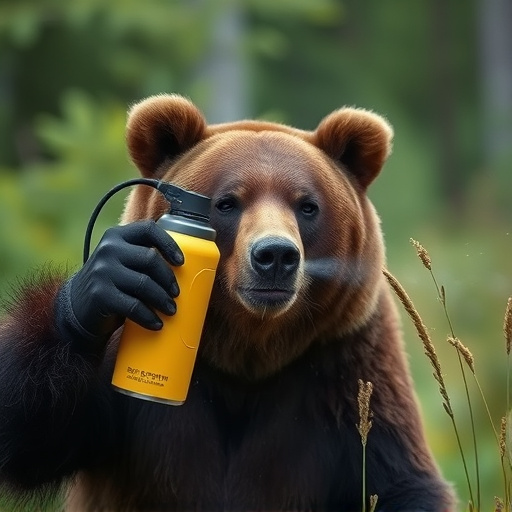Bear spray is a valuable defense against bear attacks but isn't foolproof. Its effectiveness is influenced by weather, soil contamination (from food waste), and distance. Proper usage involves understanding bear behavior, storing spray safely, and practicing application techniques. Soil contamination can impact the spray's duration, lasting up to 12 hours in ideal conditions but shorter due to factors like warmer temps, humidity, and contaminated soils. Campers should dispose of waste responsibly and be aware that even with spray, close encounters are possible.
“Enhance your camping experience with a crucial tool for bear encounters—defense spray. This article guides you through the essential aspects of bear spray, from understanding its effectiveness and safety measures to navigating soil contamination, a key factor influencing its duration.
Learn how environmental factors impact the longevity of your bear spray and discover practical tips for proper storage and usage while camping. By mastering these insights, campers can ensure a safer and more enjoyable outdoor adventure.”
- Understanding Bear Spray: Effectiveness and Safety
- The Role of Soil Contamination in Bear Encounters
- Factors Affecting Bear Spray Duration
- Essential Tips for Storing and Using Bear Defense Spray While Camping
Understanding Bear Spray: Effectiveness and Safety
Bear spray, also known as bear defense spray, is a crucial component of any camping supply kit in areas inhabited by bears. Its effectiveness lies in its ability to create a barrier between you and the bear, enabling you to escape or deter an attack. When sprayed directly into a bear’s face, the irritants in bear spray can cause temporary blindness and severe coughing, providing valuable time for retreat or self-defense.
However, it’s essential to understand that bear spray is not 100% foolproof. Factors such as wind direction, spray distance, and soil contamination can impact its duration and effectiveness. Bear spray typically has a limited range, usually around 20-30 feet, so close encounters may still result in an attack despite the spray. Additionally, proper usage techniques are vital to ensure safety; incorrect application might reduce its potency. Therefore, users must familiarize themselves with the product’s instructions and bear behavior before venturing into potential bear country.
The Role of Soil Contamination in Bear Encounters
In many camping and hiking areas, bear encounters are a potential risk, especially in regions where bears are abundant. One critical factor that can influence these encounters is soil contamination, which acts as a powerful magnet for bears seeking food. Bears have an exceptional sense of smell, and they often rely on scent trails to locate potential food sources. When campers leave behind food remnants or improperly dispose of waste, it contaminates the soil and becomes an attractive scent for bears. This contamination can last for extended periods, drawing bears into campsites and increasing the likelihood of encounters.
The duration of soil contamination varies based on several factors, including the type of food left behind, local climate conditions, and the time of year. Certain foods, such as fruits and nuts, may leave detectable scents in the soil for days or even weeks. Additionally, improper waste disposal practices, like not securing trash properly, can lead to longer-lasting contamination. Understanding this dynamic is crucial for campers to minimize their impact on bear habitats and ensure safe camping experiences.
Factors Affecting Bear Spray Duration
The duration of bear spray’s effectiveness can vary depending on several key factors, including temperature and humidity levels, wind direction and speed, and the specific formulation of the spray. In ideal conditions, with low humidity and calm winds, bear spray can remain potent for up to 12 hours or more. However, in warmer temperatures and high-humidity environments, the active ingredients may break down faster, reducing its duration.
Soil contamination also plays a role; spraying bear spray near bodies of water or in areas with heavy vegetation can lead to increased residue buildup, potentially affecting the spray’s longevity. Additionally, factors like physical barriers like clothing or skin type can influence how well the spray adheres and remains effective. Thus, understanding these variables is crucial for campers to make informed decisions about bear spray usage and ensure their safety while outdoors.
Essential Tips for Storing and Using Bear Defense Spray While Camping
When packing bear defense spray for your camping trip, proper storage is key to maintaining its effectiveness and preventing soil contamination. Always store bear spray in a cool, dry place away from direct sunlight or extreme temperatures. Keep it sealed and out of reach of children or pets. Avoid leaving it in your vehicle if it’s not climate-controlled, as extreme heat or cold can compromise the spray’s potency.
For optimal results, understand the duration of your bear spray’s protection. Typically, a single can should be enough for an entire camping trip, but factors like the terrain and local bear activity can affect this. Always inspect the spray before using it to ensure there are no blockages or damage to the canister. When confronted with a bear, follow the recommended application instructions on the label—typically, holding the can upright and spraying towards the bear’s face at close range. Remember, practice makes perfect; familiarize yourself with the spray’s operation during less intimidating situations to increase your confidence in an emergency.
When it comes to camping in bear country, understanding your defenses is key. Bear spray has proven to be an effective tool against unexpected encounters, but factors like soil contamination and duration of protection must be considered. By following proper storage and usage guidelines, campers can maximize the potential of their bear defense spray. Stay informed about local conditions and always prioritize safety when navigating potential bear habitats.
